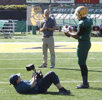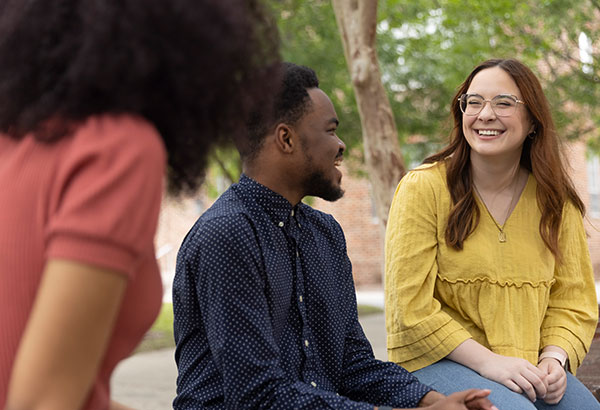‘Mythbusters’ consultant makes physics understandable
Thursday, June 16, 2016 
by: Rene Abadie
APPLYING PHYSICS TO FOOTBALL –Southeastern Associate Professor of Physics Rhett Allain observes as a “Sports Illustrated” cameraman films Lion running back Rasheed Harrell for a video that ran on the magazine’s website. In the video, Allain reviewed the impact that changing the shape of the football could have on the game.
HAMMOND – Southeastern Louisiana University Physics Professor Rhett Allain is a strong
advocate of sharing scientific views with the general public. He likes to break science
down to a more easily understandable form.
So the Discovery Channel’s show “Mythbusters,” which ended its run on TV this
year, was a natural draw for him.
In 2011, the hosts of “Mythbusters” – special effects specialists Adam Savage
and Jamie Hyneman – tried to include a scientific explanation on auto collisions for
one of their episodes. Some errors in that episode caught Allain’s attention.
Allain criticized the segment in a blog post; the producers and hosts read the
blog, then got in touch with him about serving as a physics adviser.
“They have had science advisers in the past, but not one specifically focused
on physics,” explained Allain, who worked on approximately 20 episodes. “My job was
to take something complicated and make it short and easy to understand. They generally
accepted my explanations, and I also helped select some of the myths to be featured.”
Allain generally worked with the producers, but has met the hosts via Skype. Among
his favorite episodes are the floating lead balloon, the train tanker collapse, and
the analysis of the classic question “will a bullet fired from a gun hit the ground
at the same time as one that is dropped?”
“Neither host is a scientist; they both come from a movie special effects background,”
he said. “That’s what makes the show appealing. These are just normal guys, not scientists,
who are willing to tackle various questions. Basically they do science fair projects,
but on a much larger scale. There’s value there because it does get people excited
about science.”
Allain takes his excitement about science into his classrooms and labs. Christina
Klein, a junior from Ponchatoula, La., said his approach to teaching physics made
the class fun and interesting.
“It was a class period that ran longer than most, but he made it so enjoyable
that the time really flew by,” she said. “As a childhood education major, I learned
how to teach some complex material in a way that’s understandable. It was something
that I was able to experience first-hand that I can definitely use when I have my
own classroom one day.”
Allain makes his own efforts to get others thinking about science. In addition
to his blog, he writes a regular column for “Wired Magazine” and for their online
website. He is also the author of several books, including “Just Enough Physics,”
which goes over the basic science in a first semester college or high school physics
course; “Geek Physics – Surprising Answers to the Planet’s Most Interesting Questions,”
which draws questions from movies, TV shows and viral videos; and the National Geographic
book “Angry Birds Furious Forces: The Physics at Play in the World’s Most Popular
Game.”
For Superbowl 50 earlier this year, he was asked to pen an article for “Sports
Illustrated” that examined the physics behind the building of a “better” football.
While the game itself has undergone changes over the years, he said, the football
itself has changed little.
In his article, Allain explained the physics involved in changing the shape of
the football: could it be thrown further or with greater velocity and what impact
would it have on the game?
The online piece was turned into a video by “Sports Illustrated” for use on its
website. Filming was conducted at Southeastern using several SLU players, including
one of Allain’s own students. The article and accompanying video can be found at wired.com/2015/10/how-to-use-physics-to-build-a-better-football/.
Is Allain concerned he will ever run out of questions?
“My ideas just come from being alive. I see stuff all the time that can relate
to physics in some way,” he said. “Sometimes this will come from a movie I’ve seen
or a cool YouTube video. Other times, I find stuff just in everyday life, like looking
at the differing prices of LEGO pieces or wondering why different batteries cost different
amounts. I take lots of pictures of stuff – you never know when you’re going to need
them; and I keep a list of blog ideas which come faster than I can write about them.
So I have a huge list of ideas that I can always do.”
Allain didn’t always want to be a teacher. “I wanted to be a super-cool physicist.
But once I ended up teaching labs in graduate school, I was hooked. Teaching and learning
physics attracted me in a way that made it more interesting than playing video games.”






